Traducción al español a continuación
I come from Austria, a country in the middle of Europe that is landlocked but contains beautiful mountains, lakes, and rivers. Nevertheless, I have been drawn to the Ocean for as long as I can remember. I’d like to say that this is why I became a marine biologist, but career paths are much more complicated and not only made by decisions but are also full of coincidences and luck.
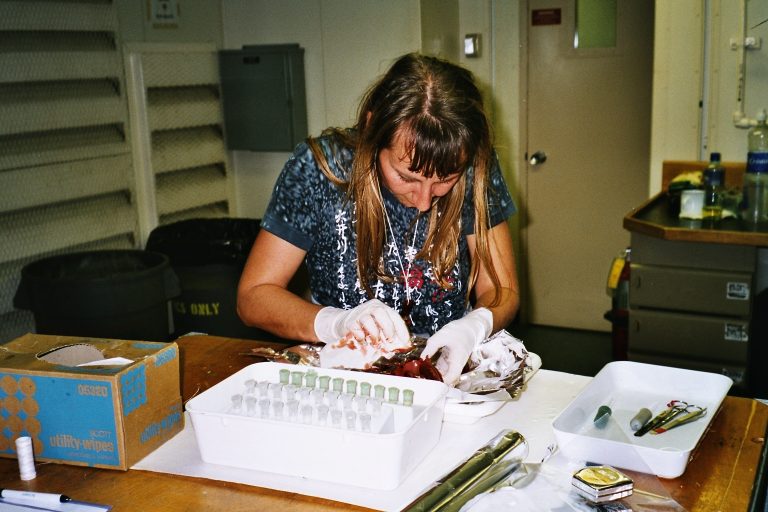
In 1992, I was invited to my first research cruise by Horst Felbeck from the Scripps Institution of Oceanography to the hydrothermal vents at the East Pacific Rise. For 26 years now, I have joined numerous expeditions with US colleagues to visit the hydrothermal vents on a very special volcano located in the Pacific. At 9°50`N, 104°17`W I began my work on the giant tubeworms. We are returning to this location to conduct research onboard the R/V Falkor (too) over the next few weeks.
The giant tubeworm, Riftia pachyptila, was discovered at the Galapagos Spreading Center over 40 years ago. It was the first animal scientists determined to live with associated sulfur-oxidizing chemotrophic bacteria. Hundreds of publications are a testament to the continuous high scientific interest in this symbiotic relationship.
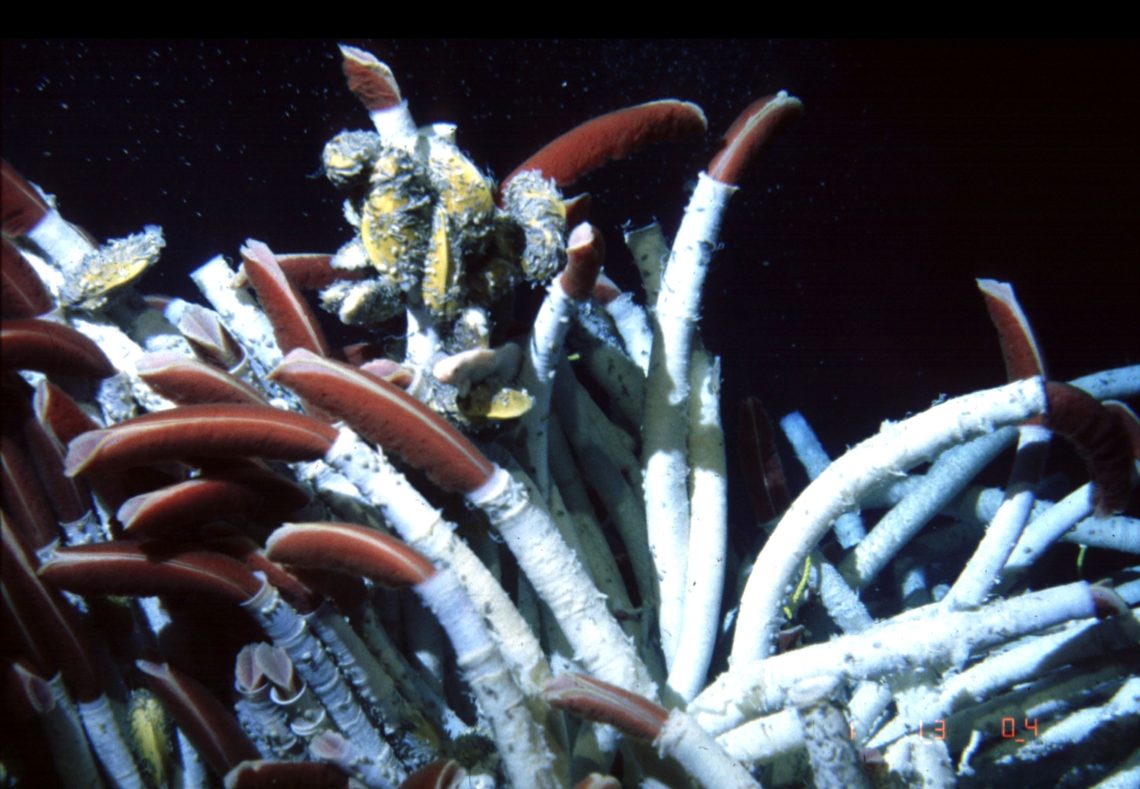
My initial interest lay in understanding how an animal that lacks a mouth and a gut as an adult picks up its sulfur bacterium, called Candidatus Endoriftia persephone, from the environment. I was also curious how they develop from a larva with a mouth and gut into a symbiotic worm with a specialized organ, the trophosome, which houses the symbiotic bacteria. My studies have helped determine that Endoriftia bacteria invade the tubeworm larva through the skin once they settle on a vent. From there, the bacteria migrate into the inner parts of the worm. The bacteria grow rapidly through chemosynthesis, and so does the host worm, which the bacteria nourish.
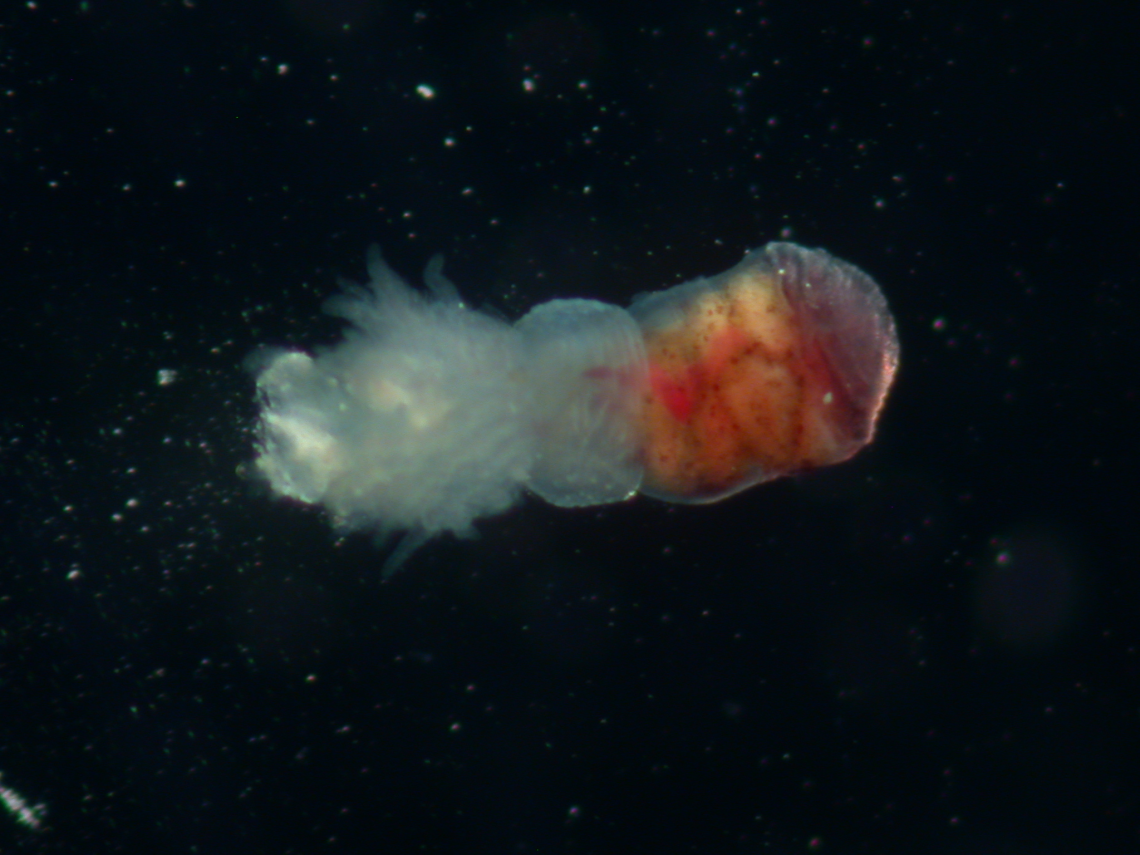
That said, in this horizontal transmission process, not only is the uptake of the symbionts from the environment important but also the bacteria’s exit back into the environment. In further experiments with high-pressure vessels in the lab, we showed that when the tubeworm dies, Endoriftia escapes the dead host tissue to settle on the inner surface of the container. The bacteria can live without their host, but the host cannot live without the bacteria.
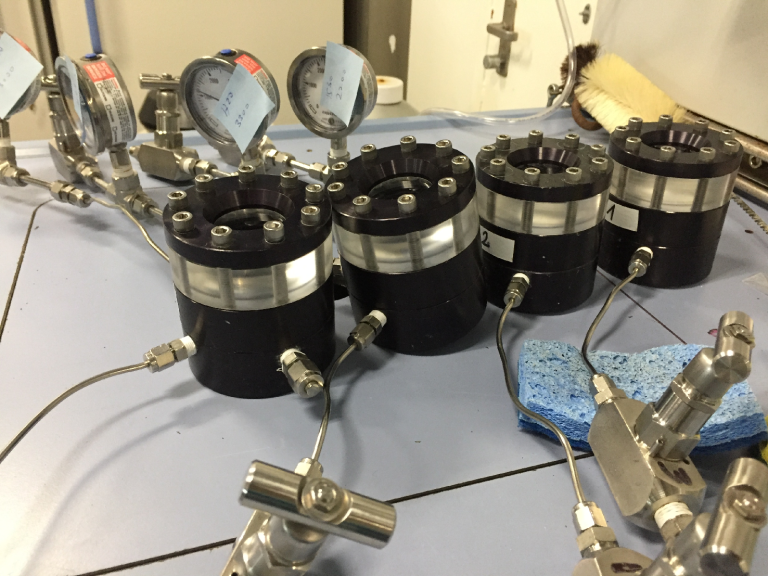
The draft genome of Endoriftia has been known for a while, but we were just recently able to finalize the genome. In addition, we published a paper with Peter Girguis and Jessica Mitchell from Harvard University on the genome of Riftia in 2022. Both publications result from data collected during a 2019 Schmidt Ocean Institute cruise to Guaymas Basin. The genomes of the host and symbiont show will aid us significantly in determining which traits are expressed by the bacteria and worms. During this cruise, Jessica Mitchell (Harvard University) and members of my lab will perform an array of experiments using high-pressure vessels.
How does Riftia Settle?
The question of how Riftia larvae settle has puzzled me for a long time. Tubeworms live on warm vents where fluid emerges from the cracks below. A tiny larva cannot swim against this water flow to settle from above. I hypothesize that the larvae may either settle when drifting at the bottom or settle from below. If larvae settle from below, then they must get sucked into the Earth`s crust to emerge from a vent. So far, my observations suggest that this may indeed be the case. In the past, I have sampled rocks below tubeworm clumps and found settled larvae and some small tubeworms that were obviously attaching to cracks in the basalt. Some worms were growing out of the rock, and others apparently got stuck in the cracks of the rock before reaching the surface. Rather than coming from above and crawling against the vent flow deeper into the rock, we believe they might have come from below with the subsurface fluid. If this is the case, we will hopefully be able to have an answer by the end of this cruise.
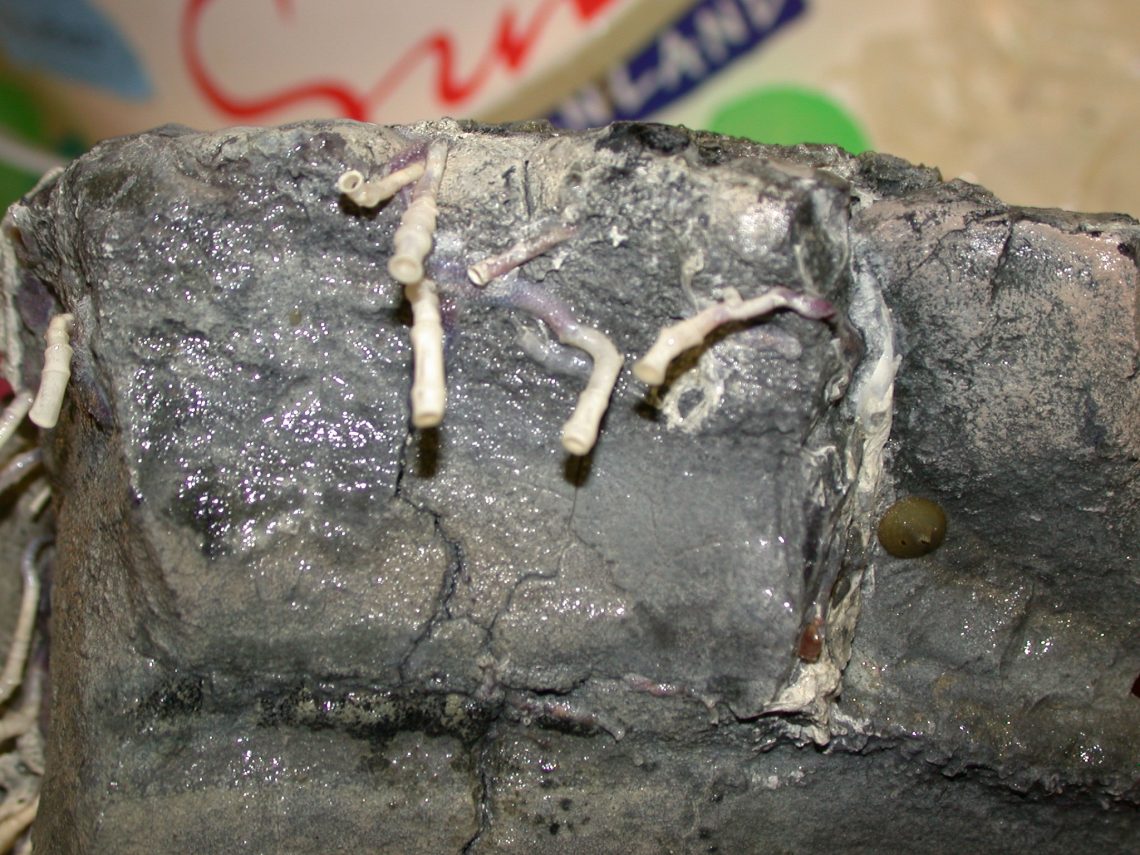
The question of tubeworm settlement ties in with a much bigger study we aim to follow in the upcoming weeks. We will explore how the microbial and animal vent community are connected to the subsurface community and how these communities interact with one another. This collaborative research has brought together a team from Europe, the United States, and Costa Rica to utilize ROV SuBastian in studying the subsurface life from viruses to animals at this one well-known volcano in the Pacific Ocean.
Gusanos gigantes en un volcán muy especial
Vengo de Austria, un país en el centro de Europa sin salida al mar pero con hermosas montañas, lagos y ríos. Sin embargo, desde que tengo uso de razón me he sentido atraída por el océano. Me gustaría decir que por eso me hice bióloga marina, pero las trayectorias profesionales son mucho más complicadas y no sólo se toman por decisiones, sino que también están llenas de coincidencias y de suerte.
En 1992, Horst Felbeck, del Instituto Oceanográfico Scripps, me invitó a mi primer crucero de investigación a los respiraderos hidrotermales de la Dorsal del Pacífico Oriental. Desde hace 26 años, he participado en numerosas expediciones con colegas estadounidenses para visitar los respiraderos hidrotermales de un volcán muy especial situado en el Pacífico. A 9°50`N, 104°17`W comencé mi trabajo con los gusanos tubícolas gigantes. Volveremos a este lugar para realizar investigaciones a bordo del R/V Falkor (también) durante las próximas semanas.
El gusano tubícola gigante, Riftia pachyptila, fue descubierto en la Cresta de Propagación de Galápagos hace más de 40 años. Fue el primer animal que los científicos determinaron que vivía asociado a bacterias quimiotróficas oxidantes del azufre. Cientos de publicaciones dan fe del gran interés científico que sigue despertando esta relación simbiótica.
Mi interés inicial radicaba en comprender cómo un animal que carece de boca e intestino en la edad adulta recoge del medio ambiente su bacteria del azufre, denominada Candidatus Endoriftia persephone. También tenía curiosidad por saber cómo pasan de ser larvas con boca e intestino a gusanos simbióticos con un órgano especializado, el trofosoma, que alberga la bacteria simbiótica. Mis estudios han ayudado a determinar que las bacterias Endoriftia invaden la larva del gusano tubícola a través de la piel una vez que se asientan en un respiradero. Desde allí, las bacterias migran al interior del gusano. Las bacterias crecen rápidamente mediante quimiosíntesis, al igual que el gusano huésped, al que nutren.
Dicho esto, en este proceso de transmisión horizontal, no sólo es importante la captación de los simbiontes del medio, sino también la salida de las bacterias de vuelta al medio. En experimentos posteriores con recipientes de alta presión en el laboratorio, demostramos que cuando el gusano tubícola muere, la Endoriftia escapa del tejido muerto del huésped para asentarse en la superficie interior del recipiente. La bacteria puede vivir sin su huésped, pero el huésped no puede vivir sin la bacteria.
El borrador del genoma de Endoriftia se conoce desde hace tiempo, pero hace poco hemos podido finalizarlo. Además, en 2022 publicamos un artículo con Peter Girguis y Jessica Mitchell, de la Universidad de Harvard, sobre el genoma de Riftia. Ambas publicaciones son el resultado de los datos recogidos durante un crucero del Schmidt Ocean Institute a la Cuenca de Guaymas en 2019. Los genomas del huésped y del simbionte nos ayudarán significativamente a determinar qué rasgos expresan las bacterias y los gusanos. Durante este crucero, Jessica Mitchell (Universidad de Harvard) y miembros de mi laboratorio realizarán una serie de experimentos utilizando contenedores de alta presión.
¿Cómo se asientan las Riftia?
La cuestión de cómo se asientan las larvas de Riftia me ha intrigado durante mucho tiempo. Los gusanos de tubo viven en respiraderos calientes donde el líquido emerge de las grietas inferiores. Una larva diminuta no puede nadar contra este flujo de agua para asentarse desde arriba. Mi hipótesis es que las larvas pueden asentarse a la deriva en el fondo o asentarse desde abajo. Si las larvas se asientan desde abajo, deben ser absorbidas por la corteza terrestre para emerger de un respiradero. Hasta ahora, mis observaciones sugieren que este puede ser el caso. En el pasado, he tomado muestras de rocas debajo de grupos de gusanos tubícolas y he encontrado larvas asentadas y algunos gusanos tubícolas pequeños que obviamente se estaban adhiriendo a grietas en el basalto. Algunos gusanos crecían fuera de la roca, y otros aparentemente se atascaban en las grietas de la roca antes de llegar a la superficie. En lugar de venir de arriba y arrastrarse contra el flujo de ventilación hacia el interior de la roca, creemos que podrían haber venido de abajo con el fluido subsuperficial. Si este es el caso, esperamos tener una respuesta al final de este crucero.
La cuestión del asentamiento de los gusanos tubícolas está relacionada con un estudio mucho más amplio que nos proponemos realizar en las próximas semanas. Exploraremos cómo la comunidad microbiana y animal de las chimeneas está conectada con la comunidad del subsuelo y cómo estas comunidades interactúan entre sí. Esta investigación en colaboración ha reunido a un equipo de Europa, Estados Unidos y Costa Rica para utilizar el ROV SuBastian en el estudio de la vida subterránea, desde los virus hasta los animales, en este conocido volcán del Océano Pacífico.

